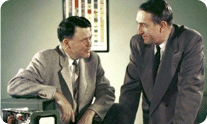One of the Most Prosperous Eras in U.S. History
Better than a long speech, the bar chart below, shows the HP personel count increase during the fifties. Spurred by World War 2-funded research, electronic technology, such as the transistor and television, evolved rapidly, both in sophistication and in demand.
HP went through a growing process in the 50s. The product line rapidly expanded with the introduction of the high-speed frequency counter and the low-frequency function generator early in the decade, followed by other landmark HP inventions, such as the sampling scope, introduced in 1958.
A typical example of the considerable growth Bill and Dave had to manage was illustrated by year 1951.
Production in 1951 increased three times over that in 1950. Net sales were $5.5 million; the year began with 215 employees and ended with 519 !
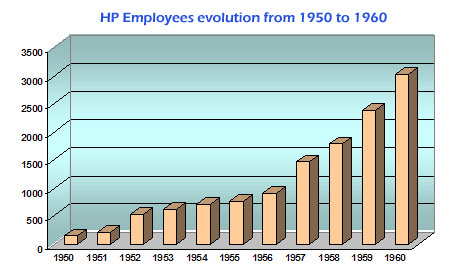 |
| HP Company Data from "The HP Phenomenon" |
New Facilities, 1951:
Such growth required obvious development. Work space was a major concern and a new building and its facilities are described in the May 1951 edition of the Hewlett-Packard journal:
Along with improvements in quality, we have been making every effort to better the delivery of HP instruments. To further this effort a new building has been added to the plant and is expected to be ready for occupancy within thirty days. This building brings HP facilities to approximately 60,000 square feet of floor space with some 400 employees.
Emphasis in the new building, as in the older buildings, is on light,
ventilation, and a high degree of flexibility. The new building is radiant-heated and walls are almost completely glass above the three-foot level. Power, air, water, and telephones are supplied through covered channels in the floor. Color schemes are professionally designed for pleasant working conditions and minimum worker fatigue.
With the new building in operation, we hope to shorten the delivery cycle on HP instruments, although material shortages continue to be a major problem.
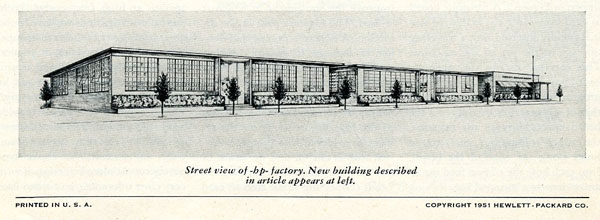 |
Photo page 1 of Hewlett-Packard Journal Vol. 2, N° 9, May 1951
Courtesy of the Hewlett Packard company |
New Facilities, 1954:
The HP plant at Palo Alto occupies an 8 acre site and contains over 140,000 square feet of laboratory, factory and office space. The new administration and laboratory building (left, on photo below) incorporates such ultra-modern features as an all-glasses front wall measuring 180 feet long by 25 feet high, electrostatically filtered air, electronically compensated temperature control and 200 to 300 foot candles of natural light in all areas.
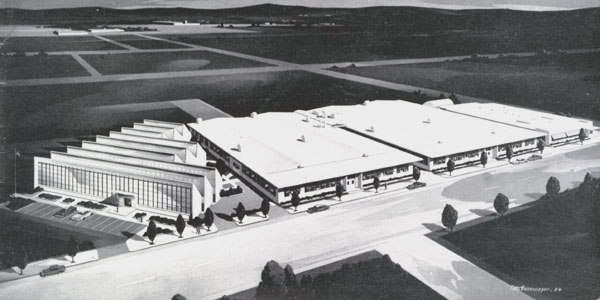 |
1954 Addition of New Administration and Laboratory Building (left)
Photo from the 1954, 15th Anniversary Issue of WATT'S CURRENT
Courtesy of the Hewlett Packard company |
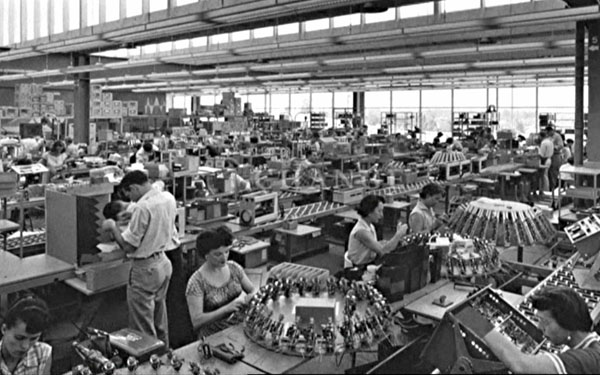 |
1957 Production Work in Palo Alto - Photo Dump from "ORIGINS" Video
Courtesy of the Hewlett Packard company |
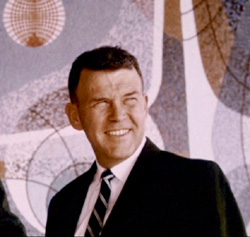 |
Bill Hewlett - Photo Dump from the "ORIGINS" Video
Courtesy of Hewlett Packard Company
|
Company Organization
Important comments about the company organization, from its birth to the end of the 50s, are given by Bill Hewlett in the introduction of his book: "Inventions of Opportunity" edited in 1983:
Let me say a word about the organizational structure of the company during its early years. Prior to 1957 we were basically a one-plant operation with one central research and development team. The company was small and intimate, with close ties between engineering, production, and marketing. By the mid-1950s, the centralized R&D lab had been subdivided into four sections: Audio-Video, an extension of the company's original product line; Microwave, a result of work started during World War II, primarily for the Bureau of Naval Research; Time and Frequency, an outgrowth of high-speed digital counting circuits (described in one of the following articles); and Oscilloscopes, a program that evolved more from a desire to have a full line of basic measurement products than from any then-existing innovative concepts.
Late in 1957, because of concern that the company was getting too large (1,500 people!) and fear that we might lose the personal touch of the small operating units which we believed was so important, it was decided to divisionalize the company using the four R&D product-line identifications described above. It should be mentioned that in making this decision we were somewhat worried that separating the units, particularly any future geographical dispersion, might adversely affect the valuable exchange of ideas among the engineering teams. Fortunately, this did not turn out to be the case, as time and again important technologies developed by one division were quickly picked up by the others.
1958 Staff
The new organization described above by Bill Hewlett is illustrated and detailed in one full page of the February 1958 Hewlett-Packard Journal:
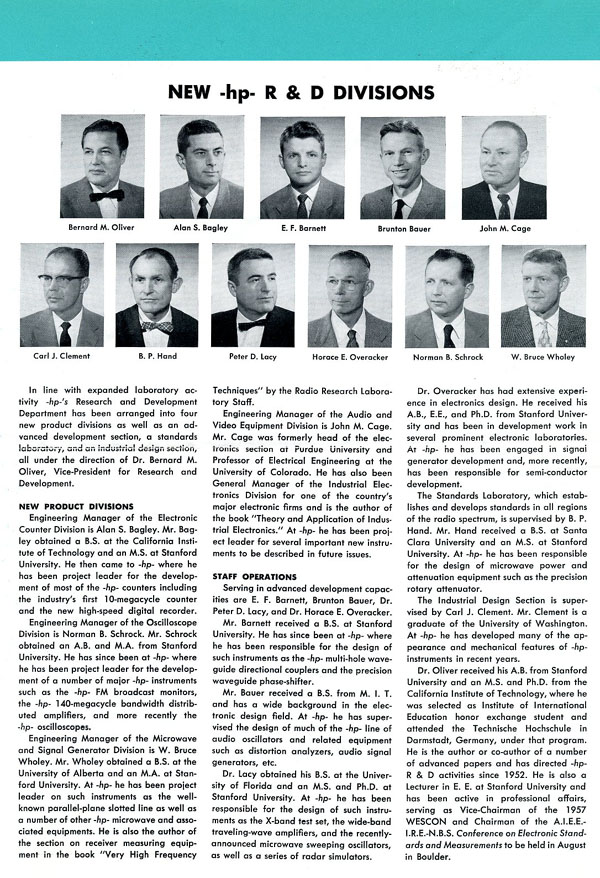 |
Page 6 of Hewlett-Packard Journal Vol. 9, N° 6, February 1958
Courtesy of the Hewlett Packard company |
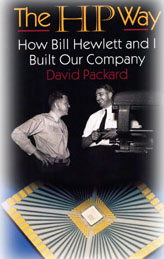 |
Cover of the David Packard book
"The HP Way"
|
1957 - HP's Corporate Objectives . . .
. . . Birth of the HP Way
About 20 HP managers sat down in 1957, at a Sonoma meeting to discuss what would become HP's Corporate Objectives. The objectives distilled the wisdom of 18 successful years of
operations and especially Bill and Dave's thoughts about what it would take to manage such a rapidly growing business and remain focused, honorable and good to their people who made it all happen.
These management philosophies, radically different from the top-down management style of many companies, were the basis of the management style that became known as the HP Way.
There were six original objectives. As time went on some were refined, based on experience with them and on changes in the business environment. A second version was published in 1966, and the objectives were as follow:
1. Profit, To recognize that profit is the best single measure of our contribution to society and the ultimate source of our corporate strength. We should attempt to achieve the maximum possible profit consistent with our other objectives.
2. Customers. To strive for continual improvement in the quality, usefulness, and value of the products and services we offer our customers.
3. Field of Interest. To concentrate our efforts, continually seeking new opportunities for growth but limiting our involvement to fields in which we have capability and can make a contribution.
4. Growth. To emphasize growth as a measure of strength and a requirement for survival.
5. Employees. To provide employment opportunities for HP people that include the opportunity to share in the company's success, which they help make possible. To provide for them job security based on performance, and to provide the opportunity for personal satisfaction that comes from a sense of accomplishment in their work.
6. Organization. To maintain an organizational environment that fosters individual motivation, initiative and creativity, and a wide latitude of freedom in working toward established objectives and goals.
7. Citizenship. To meet the obligations of good citizenship by making contributions to the community and to the institutions in our society which generate the environment in which we operate.
1959 Photo Album
At the end of the HP Company's first twenty years of activity, the front page of the1959 short-form catalog shows the following photo. It is an illustration of HP's entire product line, a total of about 350 instruments and accessories, covering almost every need for electronic measurement of the day.
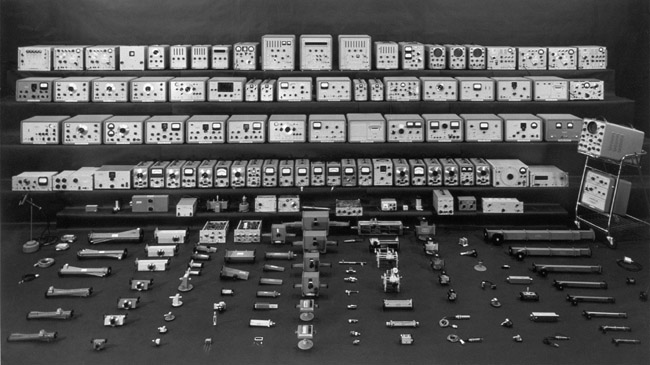 |
| 1959 Short-Form Catalog Front Page |


